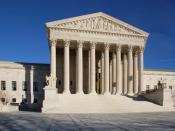Position Paper: Marilyn Manson T-Shirt vs. Van Wert Board of Education I chose to write my position paper on a case that actually happened at the school where I teach. This case happened in 1997 and just recently the final appeal was brought to the United States Supreme Court. Even though I knew the outcome, this case is very intriguing to me and I wanted to get all the facts and opinions during the course of this class.
This case involves the dress policy at Van Wert High School. The petitioner, Nicolas Boroff wore a Marilyn Manson t-shirt to school and was asked to change the shirt, turn it inside out, or go home and change in accordance to the dress policy. The policy states "cloths with offensive illustrations"æare not acceptable."àThe background of Marilyn Manson is the following. His name is derived from a celebrity, Marilyn Monroe, and a serial killer, Charles Manson.
He has acknowledged being a member of the Church of Satan and a drug user. The bands lyrics describe death, suicide, torture, racial epithets, and obscenities among other things. This would definitely be an "atypical"ÃÂ rock band. Boroff did not change the shirt or turn it inside out. He went home that day and did not return, which would be unexcused and considered truant. On the following 8 days of school, Boroff attempted to wear a different Manson shirt to school and each time was asked to do the same thing as previously stated. He refused and did not come back to school. After a meeting with school officials the mother of the boy decided to file grievance against the Van Wert City Board of Education saying that her sons 1st Amendment rights had been violated.
The information provided is what happened to get to the heart of this issue. Were Boroff's 1st amendment rights violated? That question is what must first be looked at to get a reasonable answer to this case. Tinker vs. Des Moines Independent School District was ruled on by the Supreme Court and stated this: "Students' rights to express their opinions on school grounds were protected by the 1st amendment only when students expressed those opinion "without materially and substantially interfering with the right of others."ÃÂ The Supreme Court also stated in that case that the "court gives significant deference to the judgment of citizens of the community, through their elected representatives on the school board and the school administrators appointed by them."ÃÂ This implies that the education of this Nation's youth is the responsibility of parents, teachers, and state and local officials, not of federal judges. On Wednesday, July 25 a federal judge refused to overturn a school system's ban on t-shirts bearing the Confederate Flag. In a very similar response to this particular case, he stated that the flags could be "offensive to others"ÃÂ and caused a "disruption to the educational process."ÃÂ The plaintiff, Boroff, used the same case, Tinker vs. Des Moines Independent School District to solidify his point. The case involved wearing black armbands to school to protest the Vietnam War. This could be construed as being offensive to some people because they believed in the War or had relatives who fought in Vietnam. Furthermore, the decision to not allow Boroff to wear the shirt was a restriction of his speech and discriminatory on the basis of viewpoint. Boroff's desire is a spontaneous desire for self-expression, which cannot in any way be characterized as school curriculum. The irreparable harm is that Boroff is not allowed to attend school until such time that he violates his 1st amendments rights.
My opinion is very clear in this case of Boroff vs. Van Wert City Schools. Mr. Boroff has every right to his 1st amendment rights and that of due process, but in this case it is very clear to me the result of this lawsuit. Tinker vs. Des Moines Independent School District is a perfect example to understanding the entire scope of the law and how it should be applied. The armband did not have any effect on the functional day of the school. It did not interrupt the educational process. Boroff's t-shirt had offensive, vulgar and values that were not conducive to the school's educational mission. Furthermore, this case does not present an otherwise compelling federal question. This case does not involve political speech or any other particular type of viewpoint; in fact, Boroff never identified what messages he intended to convey by wearing the shirts. The argument Boroff presents on viewpoint discrimination is also not supported. The school's prohibition did not result from nor target one Manson t-shirt depicting Jesus Christ, but rather from Manson's group promotion of disruptive and demoralizing values which are inconsistent with and counterproductive to the education process. The school is absolutely correct in not allowing the Manson shirts to be worn during the school day and is not manifestly unreasonable.
My opinion is very clear and in support of the school. The task at hand now is to make a board of education policy that coincides with the existing code of conduct in the student handbook. The student handbook read this among other things in 1997-1998. "The guidelines set forth in this dress code have been established by a dress code committee and approved by the Board of Education. It is felt that clothing with offensive illustrations, drug, alcohol"æ"àThe change I would make is fairly simple and adopted after winning the lawsuit of Boroff vs. Van Wert City Board of Education.
MODEL POLICY "The guidelines set forth in this dress code have been approved by the Board of Education. Articles of clothing that becomes disruptive and distracting to the educational process will not be tolerated. It is felt that clothing with offensive illustrations, drug, alcohol"æ"àI learned a lot from researching this topic and also from the pertinent classroom discussions about law. This is a case that is a victory for the school system and teachers throughout the United States. Schools must be able to set guidelines, rules, and regulations to effectively teach the future of America.





